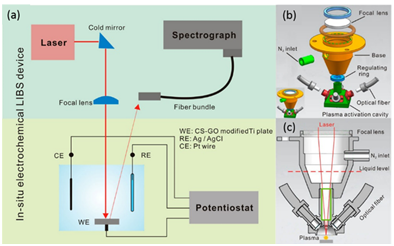Contamination containing trace heavy metal ions (HMIs) has drawn great attentions due to it poses serious threats to ecological system and human health. Recently, electrochemical spectral methods have gradually become a research hotspot of the trace detection for HMIs with super low detection limits, great sensitivity and anti-interference, and fruitful achievements have been made.
A related review entitled “Electrochemical spectral methods for trace detection of heavy metals-A review” written by Prof. HUANG Xingjiu’s team in Institute of Intelligent Machines (IIM), Hefei Institutes of Physical Science, has been published in Trends in Analytical Chemistry. https://www.sciencedirect.com/search?pub=TrAC%20Trends%20in%20Analytical%20Chemistry&cid=271490&show=25&sortBy=relevance..
In this review, they primarily described the recent advances of representative electrochemical spectral methods and their applications.
They found that electrodeposition became an effective mean for the preconcentration of HMIs ahead of atomic absorption spectrometry(AAS), total reflection X-ray fluorescence and X-ray fluorescence(TXRF/XRF)and laser-induced breakdown spectroscopy (LIBS), and electroadsorption also was used as a preliminary procedure for XRF, LIBS, on the basis of electrostatic force.
Furthermore, these electrochemical spectral methods were demonstrated to be capacity of the in-situ detection of target HMIs, providing a good alternative for the daily environmental monitoring for HMIs, and a typical in-situ underwater EA-LIBS devicewas presented in figure 1 (Imaged by JIANG Tian-jia).
Based on the overview of these methods, researchers also addressed up-to-date challenges of in-situ electrochemical spectral methods, for which additional researches are needed to carry out as following.
1)It is essential to decrease the analysis time as the environmental pollution is changeable.
2)More works should be carried out to investigate the great anti-interference ability of electrochemical spectral methods.
3)Studies focused on the easy-to-use integrated experimental setup of electrochemical spectral methods should be carried out to realize the on-site monitoring for HMIs.
This work was supported financially by the National Natural Science Foundation of China (21735005, 21475133, U1532123, 61573334, and 61474122), the Postdoctoral Innovation Talents Supporting Project (BX20180311), the Youth Project of National Natural Science Fund of China (11405256), and Major Science and Technology Special Project in Anhui (17030801033). X.-J.H. acknowledges the CAS Interdisciplinary Innovation Team, and Hefei Institutes of Physical Science Director’s Fund (YZJJ201701), for financial support.

Figure 1.Experimental apparatus of in-situ underwater EA-LIBS device. (a) schematic of EA-LIBS device, (b) deconstructed arrangement, (c) sectional view of the gas-assisted localized liquid discharge setup. (Imaged by JIANG Tian-jia)
Article link:https://www.sciencedirect.com/science/article/pii/S0165993618302231
Title: Electrochemical spectral methods for trace detection of heavy metals: A review
Key words: Heavy metal ions (HMIs); Electrochemical spectral methods; Electrodeposition; Electroadsorption; AAS; TXRF; XRF; LIBS.
Prof. HUANG Xing-Jiu, Ph. D Principal Investigator
Institute of Intelligent Machines, Chinese Academy of Sciences(http://www.iim.cas.cn/), Hefei 230031, China
Tel: 86-551-6559-1167
Email: xingjiuhuang@iim.ac.cn
